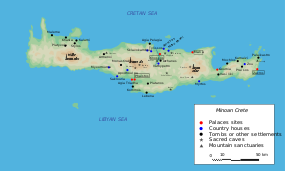Zakros
 Map of Minoan Crete | |
| Coordinates | 35°05′53″N 26°15′41″E / 35.09806°N 26.26139°E |
|---|---|
| Type | Minoan town and "palace" |
| History | |
| Cultures | Minoan |
| Site notes | |
| Excavation dates | 1901 |
| Archaeologists | D.G. Hogarth |
| Public access | Yes |
Zakros (Greek: Ζάκρος; Linear B: 𐀼𐀒𐀫 zakoro;[1] also Zakro or Kato Zakro) is a Minoan archaeological site on the eastern coast of Crete. It is regarded as one of the five Minoan palaces, and its protected harbor and strategic location made it an important commercial hub for trade to the east.


The town was dominated by the Palace of Zakro, originally built around 1900 BC, rebuilt around 1600 BC, and destroyed around 1450 BC along with the other major centers of Minoan civilization. Extensive ruins of the palace remain, and are a popular tourist destination.
It has been proposed that the ancient name of the site was Ditka.[2]
Geography
Zakros is sometimes divided into Epano Zakros (Upper Zakros), the portion higher up on the hillside, and Kato Zakros (Lower Zakros), the part near the sea. A ravine known as the "Ravine of the Dead" runs through both the upper and lower parts of the ancient site, named after the numerous burials that have been found in the caves along its walls.
Epano Zakros is 38 km (24 mi) from Sitia. The road passes through Palekastro where it doubles back towards the south. A comparatively large village, Zakros includes in its community the following smaller villages: Kato Zakros, Adravasti, Azokeramos, Kellaria, Klisidi and the small hamlets of Ayios Georgios, Sfaka, Kanava and Skalia. The asphalt road ends at Kato Zakros.
Archaeology
The site was first recorded by Thomas Abel Brimage Spratt in 1851.[3]
Zakro was excavated by D.G. Hogarth of the British School of Archaeology at Athens in 1901 working primarily in the central area.[4][5][6] Human remains were found in caves at the gorge.[7]
In 1961, Nikolaos Platon resumed the excavation and discovered the Palace of Zakro. This site has yielded several clay tablets with Linear A inscriptions.[8]
A number of seals, mainly of steatite, and clay sealings have been found at Zakros.[9][10][11]
References
- ^ Richard Vallance Janke, The Rôle of Supersyllabograms in Mycenaean Linear B, Presentation at the Pultusk Academy of Humanities, Poland, June 30 - July 2, 2015, p. 4.
- ^ [1]Huxley, George, "The Ancient Name of Zakro", Greek, Roman, and Byzantine Studies 8.2, pp. 85-87, 1967
- ^ Thomas Abel Brimage Spratt (1865). Travels and Researches in Crete. J. van Voorst. OCLC 1000662504. Volume 1
- ^ D.G. Hogarth, "Excavations at Zakro, Crete", Annual of the British School at Athens 7, pp. 121-49, 1901
- ^ Dawkins, R. M., "Pottery from Zakro", The Journal of Hellenic Studies 23, pp. 248-260, 1903
- ^ [2]Hogarth, David George, "Bronze-age vases from Zakro", The Journal of Hellenic Studies 22, pp. 333-338, 1902
- ^ W. Boyd Dawkins, "Skulls from cave burials at Zakro", Annual of the British School at Athens 7, pp. 150-55, 1901
- ^ Jan G. P. Best and Fred Woudhuizen, Lost Languages from the Mediterranean, 1989, Brill Archive ISBN 90-04-08934-9
- ^ Hogarth, D. G., "Note on two Zakro sealings", Annual of the British School at Athens 17, pp. 264-265, 1911
- ^ [3]Weingarten, Judith, "Aspects of tradition and innovation in the work of the Zakro Master", Bulletin de Correspondance Hellénique 11.1, pp. 167-180, 1985
- ^ Weingarten, Judith, "Two inscribed sealings from Zakro", Kadmos 22.2, pp. 107-108, 1983
Further reading
- Bosanquet, R. C., "Excavations at Palaikastro. II: § 3.—The Chronology of Palaikastro and Zakro", Annual of the British School at Athens 9, pp. 281-287, 1903
- [4]Nikolaos Platon, "Zakros: The Discovery of a Lost Palace of Ancient Crete", Scribner, 1971 ISBN 978-0684311036
- Platon, Lefteris, "Studying the Character of the Minoan 'Household' within the Limits of the Neopalatial Settlement of Zakros", Hesperia Supplements 44, pp. 151-161, 2011
- Thompson, James G., "Clues to the location of bull jumping at Zakro", Journal of Sport History 19.2, pp. 163-168, 1992
- Weingarten, Judith, "The use of the Zakro sealings", Kadmos 22.1, pp. 8-13, 1983
External links
- Articles with short description
- Short description matches Wikidata
- Coordinates on Wikidata
- Articles containing Greek-language text
- Articles containing Mycenaean Greek-language text
- Articles with VIAF identifiers
- Articles with BNF identifiers
- Articles with BNFdata identifiers
- Articles with Pleiades identifiers
- Populated places in Lasithi
- Sitia
- Minoan sites in Crete
- Populated places in ancient Crete
- Former populated places in Greece
- Aegean palaces of the Bronze Age
- All stub articles
- Ancient Crete geography stubs